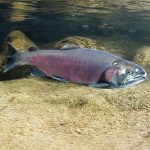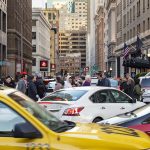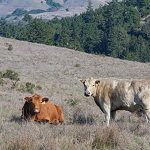Welcome to Monitor Notes, a weekly roundup of news items, event announcements, and updates on past Bay Area Monitor articles.
Time for a Swim
 Each winter, salmon journey from their ocean feeding grounds to natal, rain-filled streams to spawn. Lagunitas Creek Watershed in Samuel P. Taylor State Park happens to be home to the largest remaining run of wild Central California Coast Coho Salmon. So take a creekside tour to see endangered salmon at the spawning season peak. Tours start December 7 and run each Saturday through January 24. A $15 donation per person is suggested for public tours; kids 12 and under are free. Register here. To get into the swim of things, read Monitor coverage about Bay Area watersheds removing barriers to aid migratory fish.
Each winter, salmon journey from their ocean feeding grounds to natal, rain-filled streams to spawn. Lagunitas Creek Watershed in Samuel P. Taylor State Park happens to be home to the largest remaining run of wild Central California Coast Coho Salmon. So take a creekside tour to see endangered salmon at the spawning season peak. Tours start December 7 and run each Saturday through January 24. A $15 donation per person is suggested for public tours; kids 12 and under are free. Register here. To get into the swim of things, read Monitor coverage about Bay Area watersheds removing barriers to aid migratory fish.
The Congestion Price Is Right?

The San Francisco County Transportation Authority is mulling congestion pricing strategies in downtown and SoMa during busy hours to keep traffic flowing. How do you feel about the potential for fees? Tell San Francisco officials in a 10-minute survey. They’re trying to understand whether congestion pricing could be an effective and fair way to unclog streets. In April, the Monitor reported that San Francisco is among several large U.S. cities considering tolls, a move that could help reduce car emissions and improve commuters’ safety and quality of life. Read more about the Authority’s study here and how you can participate in a related Policy Advisory Committee meeting on December 12 at 6 p.m.
Herd About the Workshop?

The Midpeninsula Regional Open Space District is hosting a December 17 workshop from 6 to 8 p.m. in Mountain View to discuss its conservation grazing policy and get feedback about preventing predator-livestock conflicts (mainly mountain lions and coyotes preying on cattle). Its grazing program protects native grasslands, manages vegetation, and supports agriculture. But Midpen is now exploring options like reimbursements for livestock losses, as well as reduced rental rates and predator deterrents like noise/visual preventions, guard animals, and fencing. Click here for workshop details and Midpen program information. Forage this Monitor article to read about thinking behind conservation grazing and other districts using the approach to pare down plant growth and wildfire risk.
Concrete Solutions

The County of Marin is making building policy changes to minimize the use of cement, the powdery glue that binds concrete. The new code focuses on the use of “supplementary cementitious materials,” which are as effective as cement but come with lower emissions. Concrete is the source of up to 10 percent of human-created carbon dioxide emissions, Marin County officials said in a press release. Other Bay Area counties may also follow Marin’s lead and remove concrete barriers. Bill Kelley, deputy director at the Marin County Community Development Agency, said the updated code language was designed as a model for other local governments, a detail hardened into the Bay Area Air Quality Management District grant that helped fund the effort.
Monitor Notes is produced by Cecily O’Connor. To receive it by email, scroll to the bottom of this page, enter your email address in the box under “RECEIVE EMAIL UPDATES,” and click the red “SIGN UP” button.